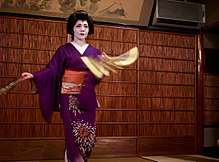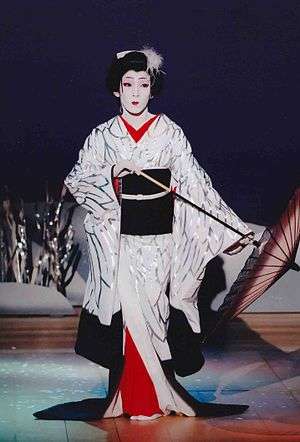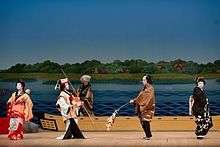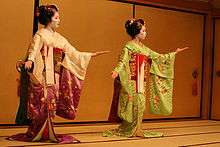Buyō

Buyō (舞踊), or Nichibu (日舞) short for Nihon buyō/Nippon buyō (日本舞踊) meaning Japanese dance,[1] refers to a traditional Japanese performing art that may be a mixture of dance and pantomime. It begins with early dance traditions such as mai and odori, with major development in the early Edo period (early 17th century) in the form of kabuki dances, which incorporated elements from the older dance genres.[2] Although the term Nihon buyō means "Japanese dance", it is not meant to refer to Japanese dance in general, rather it refers to a few dance genres such as kabuki buyō performed in theatre, and Kamigata mai that encompasses the style of dancing performed by geisha.[3] Nihon buyō differs from other Japanese traditional dances in that it is a more refined style of dancing intended as entertainment on a public stage or in private functions.[1][3]
The term buyō is a modern coinage during the Meiji period as a general term for "dance", and the writer Tsubouchi Shōyō is believed to be the first to use the term Nihon buyō.[4] Prior to this, dance was generally referred according to its particular dance genre, such as mai and odori. The term is a combination of mai (舞, which can also be pronounced bu) and odori (踊, can also be pronounced yō).[5]
Influences and components

Nihon buyō is a broad genre of dances that have been refined and improved over four centuries.[1] There are three main elements to Nihon buyō – mai, odori, and furi. Mai is a refined, reserved, and expressive style of dance with few jumps or quick movements; odori is a more energetic dance style, with leaps and lively movements; and furi is the gestures and pantomime movements from kabuki dance.[4]
There are four main parts or influences that are the building blocks of Nihon buyō, the most significant of these being kabuki buyō.[1]
Kabuki
Dances in kabuki theatres are based on earlier dance traditions, and have the three principal aspects of mai, odori, and furi, as well as incorporating michiyuki borrowed from bunraku dance scenes. The kabuki buyō started in the early 17th century, grew within the framework of the kabuki theatre and became fully developed in the late 17th through mid 18th century by onnagata.[2]
Noh
The second part of Nihon buyō is noh.[1] Nihon buyō takes a few key elements from noh such as the circular movements and the tools used in its dances.
Folk dances
The third component comes from elements of folk dances. Folk dances are among the earliest of dances in Japan, and they form the basis of many later dance genres. The spinning and jumping movements used in folk dances have become incorporated into Nihon buyō.

Shin Buyō
The last part arose out of influences from European and American culture introduced in the modern era in Japan.[1] The writer Tsubouchi Shōyō, said to be the originator of the term Nihon buyō,[4] proposed changes to kabuki theatre under the influence of Western art forms. These ideas were adopted by some kabuki actors, and also led to the development of a new dance form termed shin buyō.
Shin buyō (新舞踊, new dance) began in the early 20th century during the Taishō period when kabuki dancer-actors began to experiment with new approaches to kabuki theatre.[6] Dances on traditional and classical themes may be performed with new choreography, and contemporary popular music may be used to accompany the dance. In the mid 20th century performers, choreographers, non-kabuki dance masters including geishas created experimental shin buyō dance groups.[2]
Categories
.jpg)

Nihon buyō may also be grouped into four main categories: kabuki buyō, su odori, kamigata mai, and sōsaku buyō.[7]
- Kabuki buyō (歌舞伎舞踊) – Kabuki buyō is performed in typical kabuki setting, costume and design. A notable example of the dance is The Dancing Girl at the Dojoji Temple (京鹿子娘道成寺, Kyoganoko Musume Dojo-ji), a performance in which the onnagata dances for nearly an hour.[8][9][10]
- Su odori (素踊り) or goshugimono (御祝儀物) – this is a stripped down version of a dance that is related to Kabuki buyō. It is performed in a formal kimino but usually without other dance costuming or staging, with the dancer often using only a fan.[11] The fan is the most important prop in Nihon buyō, and can be used to represent various other objects in the dance.
- Kamigata mai (上方舞) – Named after the Kamigata region of Kyoto and Osaka, this include pieces performed by geishas. The dance developed in the Tokugawa period as a dance for private parties or dinners of patrons, and may be performed in spaces as small as one tatami mat. It is most often performed by women and its movements are typically slow and gentle.[3][12]
- Sōsaku buyō (創作舞踊) – it means "original buyō", and includes dances with modern choreography.[7]
References
- 1 2 3 4 5 6 "What is nihon buyo?". Archived from the original on 2006-07-07. Retrieved 2006-05-06.
- 1 2 3 Samuel L. Leiter (1 October 2014). Historical Dictionary of Japanese Traditional Theatre (2nd ed.). Rowman & Littlefield. pp. 55 &ndash, 57. ISBN 978-1442239104.
- 1 2 3 Takashi Izuha, Keiichiro Uetsuki & Mieko Marumo. "Shoyo's Nihon Buyo" (PDF). Society of Dance History Scholars Proceedings: 94–97.
- 1 2 3 Tomie Hahn (7 May 2007). Sensational Knowledge: Embodying Culture Through Japanese Dance. Wesleyan University Press. pp. 27–28. ISBN 978-0819568359.
- ↑ Oshima, Mark (29 June 2009). Sandra Buckley, ed. The Encyclopedia of Contemporary Japanese Culture. Routledge. p. 75. ISBN 978-0415481526.
- ↑ Samuel L. Leiter (2013-04-17). Kabuki at the Crossroads: Years of Crisis, 1952-1965. Martinus Nijhoff Publishers / Brill Academic Publication. p. 55. ISBN 9789004251144.
- 1 2 Hahn, Tomie (2007-05-07). Sensational Knowledge. Wesleyan University Press. p. 24. ISBN 9780819568359.
- ↑ "Kyoganoko Musume Dojo-ji(The Dancing Girl at the Dojoji Temple)".
- ↑ "Kyoganoko Musume Dojoji". Japan Arts Council.
- ↑ "The Maiden at Dojoji Temple". Kabuki Play Guide.
- ↑ "Su-odori 素踊り". Japanese Performing Arts Resource Centre.
- ↑ Raju Thakrar. "Kyoto style comes to Edo". The Japan Times.
External links
- Nihon Buyo Foundation
- Nihon Buyo delights UK Audiences - May 16, 2005 Archived July 26, 2006, at the Wayback Machine.
- Tachibana School of Nihon Buyo*
- "Kyoto Buyo". Archived from the original on 2009-10-17. Retrieved 2009-03-28.